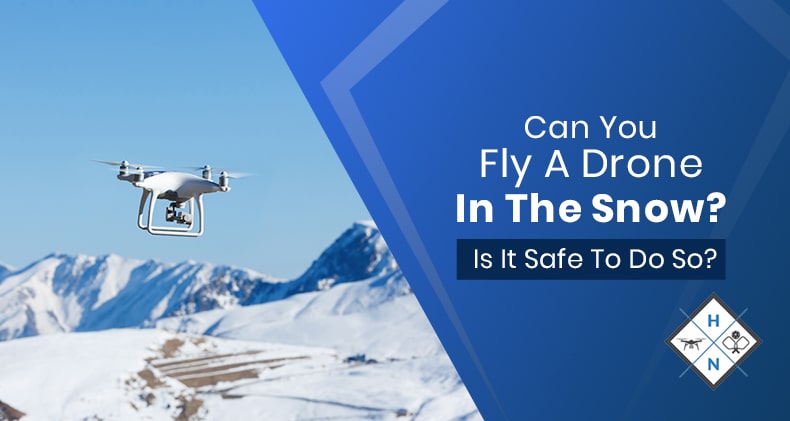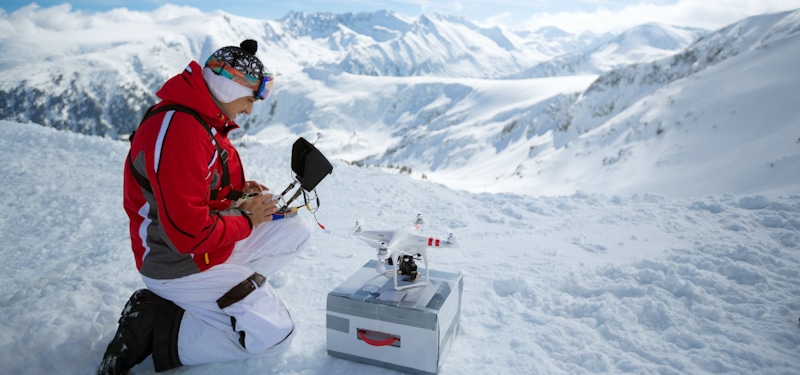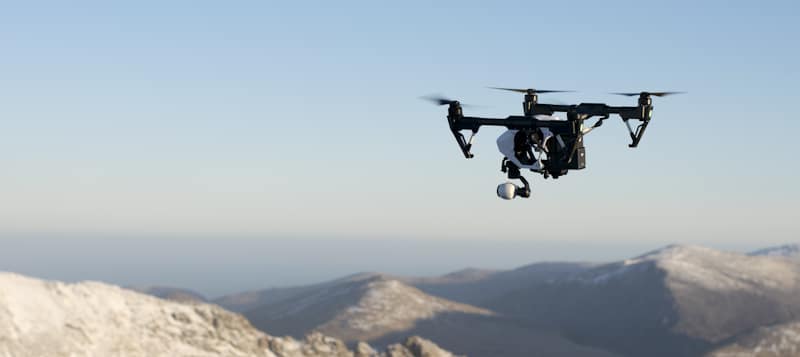The ideal weather to fly a drone is sunny, bright – somewhere around 75°F (23.9°C). When the weather is warm, it's also well lit up, which helps capture some brilliant footage. During winter or snow, however, it's not as bright, and the drop in temperature can hamper drone functionality.
Flying a drone in the snow is possible if you take care of a few things. The drone must be waterproof or water-resistant, its battery should be warm and fully charged, the drone should be devoid of moisture when it's not flying, etc. Most importantly, the snowfall mustn't be heavy or snowstorm-like.
If you'd like to lean in on the details regarding how snow is detrimental to a drone and its insides, tips/tricks to extract a few minutes of flight during snow, and everything else related to the topic, keep reading.
Why Flying a Drone in the Snow is Problematic?
Though there's no doubting how fun it can be to fly a drone in the snow and peruse the shots taken, there are some severe impediments to the activity that prevent or discourage most drone users from flying their drones in snow.
Visibility Issues
Visual-line-of-sight (VLOS) is critical when flying a drone.
When it snows or rains, fogging happens, and visibility is reduced severely. In other words, the drone's obstacle avoidance or stabilization sensors barely detect the snow's pure white surface or identify it as a potential "obstacle". Also, the snow blanket can create a significant amount of glare, ruining your otherwise great aerial shots.
The reduced visibility means the drone is highly likely to crash. Recovering the crashed drone is another challenge because you have no control, or you cannot predict when or where the drone comes to an abrupt stop and descends in a straight line from the sky.
And if the ground has a thick snow cover, the crashing drone could land in a pile of snow, causing further damage to the machine.
Stability Concerns
Flying a drone in the snow is challenging, mainly if the drone employs cameras to help with navigation and stability. The snow offers little to zero contrast for the drone's cameras to discern motion. And if there is heavy precipitation, strong winds are likely.
Despite the various stabilization technologies the drone could be equipped with, a single powerful gust of wind could disrupt the airflow the drone depends on for its lift. Strong wind is usually reason enough to abort drone operations.
When your drone loses stability, it's likely to crash unceremoniously. As mentioned above, if it crashes down into the snow, rescuing the drone may not be that difficult. But if the strong wind sways the drone and causes it to crash into a tree or any place that's not easy to access, retrieving the drone would become a challenge in itself.
Water Damage
Snow is nothing but crystallized or hardened water. When the frozen water hits the drone's warm motors and batteries, it melts and becomes free-flowing water. And when the electronics in your drone come in contact with the melting snow, they are bound to get wrecked and bring the drone down with them.
"Electronics and water do not mix" is common knowledge. Exposure to even a tiny amount of water can bring a dramatic end to a drone's flight. Not to mention, flying a drone when it's raining or even misting is advised against strictly.
Even if the drone's water damage does not pop right away, the moisture exposure could corrode the drone's metal parts quickly than usual. Over a period, this would lead to reduced mechanical strength and electricity conduction.
Before that could happen, the motors and wires' exposure to moisture could cause short circuitry. This phenomenon occurs when a power source's negative and positive terminals get connected with no load. With no current outlet, rapid conversion to heat energy takes place. And this further harms the drone's motors, wires, and control board.
How to Safely and Effectively Salvage a Water-Affected Drone?
When a drone is water-damaged, you may invariably have to send it in for repairs, particularly if the inner circuitry is fried. The costs of repair can be high – often as high as the drone's price. Moreover, the repaired drone may not feel or function like it did before its tryst with water.
It's always best to ensure your drone is not exposed to even the tiniest amount of liquid.
If you are flying a drone in the snow, make sure you're using a waterproof device – at least something that's water-resistant. A waterproof drone doesn't guarantee complete protection against water ingress, but it certainly reduces its chances.
Whether you use a waterproof drone or one without built-in protection against fluids, the chances of water damage cannot be ruled out. If your drone is affected by water, here are a few things you can or should do to recover the device or before sending it to the service center:
- Wrap the wet drone in a clean, dry cloth and place it in a bucket fully covered with rice. Based on the water damage level, it could take anywhere between 12 hours to a couple of days for the drone to dry completely.
- Do not connect the wet drone to power until it's almost scorched.
- If the drone is snow-infested, wipe the snow off with a towel or blow it out with some compressed air. Dismantle the drone completely before wiping it off or even placing it in the rice bucket.
Fly the drone again only after having checked its motor, camera, battery, etc. If you need professional help for the inspection, hire one.
The Water-Resisting Ability of Your Drone
Not all drones are made the same. Even those claiming to be "waterproof" or "water-resistant" do not provide the same level of protection against penetrating fluids.
Drones that are extremely capable of keeping water at bay are usually on the expensive side. The affordable drones that get marketed as "waterproof" offer the least amount of liquid protection – the bare minimum level to qualify as "water-resistant".
Drone and IP Rating
A drone's IP (Ingress Protection) rating ascertains how capably the machine prevents water from getting in. An IP rating is a globally recognized standard representing how well a piece of electronics is safeguarded against liquids and solids.
An IP rating is denoted by a two-digit number – the first digit indicating the dust protection level and the second numeral representing water-resistance level. IP66, IP45, IP54, etc., are some of the ratings given. The higher the number, the greater the protection against dust and water.
IP45, for instance, denotes the drone is well-protected against objects that are 1mm thick or bigger. Solid items smaller than 1mm may still penetrate the drone. On the liquid protection side of things, the rating indicates the drone is safeguarded against water jets. Water ingress up to a certain level is permitted. IP54 signifies a greater level of protection against water and dust splashes.
Kindly note, drones with respective IP ratings claim "limited" protection against water and dust. Even the ones with the highest rating are not entirely impervious to the elements.
An IP rating is, therefore, no excuse to be careless and irresponsible with your drone. In other words, if it's snowing heavily, do not expect the IP rating to shield your drone from the snow and the precipitation completely.
If a drone with an IP rating is affected by water or dust, repair costs may or may not be covered under warranty.
Tips to Flying a Drone in the Snow
What would it be like to have a bird's eye view of a snowfall? A drone promises to offer just that, which is where the temptation to fly a drone in the snow lies.
If you are aware of the pitfalls associated with flying a drone in the snow and still want to try it out, here are a few tips/tricks that shall help it make a happy, safe outing:
Steer Clear of Moisture as Much as Possible
Avoid any moisture that can potentially damage your drone's electronics. If it's snowing, ensure your drone is appropriately covered in some waterproof material until the moment it's ready to fly.
Also, before taking the drone out, make sure it's dry. Any kind of moisture could turn into ice in the snowy weather, increasing the chances of the drone's exposure to water and subsequent crashing.
No Appendages, Please!
During snow or frigid conditions, the drone has to work harder than usual to keep its battery, motor, and other components adequately warm. This additional work eats into the battery or the drone's flight time takes a significant hit.
But the thing that makes things even worse are attachments. In other words, do not burden your drone with a 360° camera or anything that adds heft. The snow already weighs down the drone. You shouldn't do anything that adds to that.
The heavier the drone, the lesser will be its flight time—also, the likelihood of crashing increases when the drone is not allowed to fly as it is.
Don’t Enter the Clouds
Do not fly your drone into the clouds. The snow is already posing visibility and stability challenges to the drone. You don't want to exacerbate that situation by venturing into the clouds.
Clouds consist of moisture. By flying the drone into the clouds, ice building over and around the drone only increases, causing myriad problems.
Do Not Fly Very High
Altitude matters when flying a drone – more so in wintry conditions. The higher the drone goes, the faster its propeller should rotate for the drone to stay put in the air, thanks to the air at higher altitudes being thinner. And when the propellers move faster than usual, the battery drains quicker, which negatively affects the flight time.
Don’t Fly When It’s Snowing Heavily
If the snowfall is something like white dust descending from the sky, it's okay to take your drone out. But if there's a snowstorm-like situation, it's strictly advised not to venture out with your drone. It doesn't matter how strongly built your drone is. Even the most robust, high-end drones will call it quits when subjected to heavy snow.
A Few Other Tips
Besides those mentioned above, keep the following tips in mind too:
- Make sure the batteries are in their optimal state. They should be fully charged right before the flight. Keeping the batteries 100% charged a week or even a few days before the flight is not good enough. The batteries should be warm to the touch too. Don't insert the battery into the drone when it's cold. Use some kind of warmer to warm up the cell.
- If the drone is connected to your phone, make sure the phone is fully charged. Also, wear gloves or use hand warmers to keep your fingers toasty and able enough to use the phone and the drone controls. Make sure the gloves you wear do not come between your phone and your fingers.
- Test the drone before the actual flight to ensure everything is on track. A 30-second to 1-minute test flight is fine to test things. If there are issues or niggles, those will come to the fore during the test flight. It is much easier to look into the problems during the test hover or when the drone is not thousands of feet away.
- Do not push hard on the throttle any time during the flight – certainly not when the flight is just about to begin. The chances of the drone crashing are higher in the snow when you push it harder suddenly.
Conclusion
Though drones fly best in warm, bright weather conditions, they're versatile enough to fly when it's cloudy outside or the temperatures are cooler or hotter than average. Things become troublesome only when it's precipitating, freezing, or extremely windy outdoors.
Even if you're flying a drone in ideal conditions, there's always an element of risk involved in gliding a thousand-dollar piece of equipment out of reach. And when it's snowing, the risk quotient increases multifold.
But, as mentioned above, there's a certain charm to flying a drone during the snow. The risk to reward ratio is balanced or even tilting in favor of the "reward" side. Before you go ahead with flying your drone in the snow, however, make sure you are on top of all things you must know.
Shawn Manaher loves to play with new toys and dive into new hobbies. As a serial entrepreneur, work definitely comes first but there is always room for hobbies.





